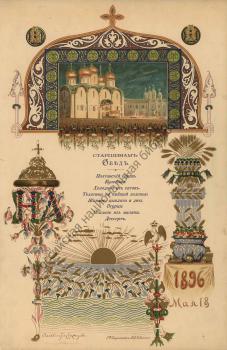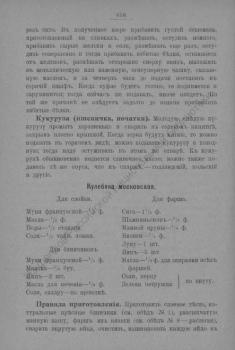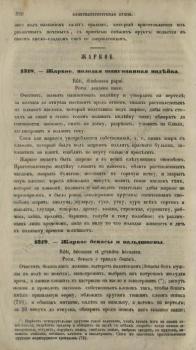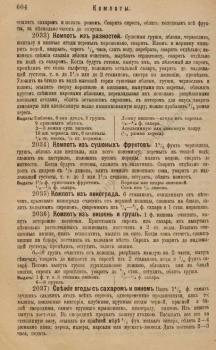Petersburg Cuisine
A. M. Vasnetsov. Menu of the Lunch for Volost Headmen in the Petrovsky Palace near Moscow on May 18, 1896 on the occasion of the coronation of Emperor Nicholas II and Empress Alexandra Feodorovna.
A.A. Levenson Printshop (Moscow). 1896.
Chromolithograph. 42,2х27,6 cm.
See in the Digital Library of the National Library of Russia
Dish Recipes
Moscow Coulibiac
For the puff pastry:
French flour — ½ Russian pound
Butter — ½ Russian pound
Water — ½ Russian pound
For pancakes:
French flour — ½ Russian pound
Milk — ½ bottle
Eggs — 2 pcs.
Butter for baking — 1/8 Russian pound
Salt, sugar — a pinch each.
For filling:
Sig — ½ Russian pound
Mushrooms — 3/8 Russian pound
Semolina — 1/8 Russian pound
Vesiga — ¼ Russian pound
Onion — 1 pc.
Eggs — 5 pcs.
Butter — ¼ Russian pound for all the filling
Salt, pepper, parsley — to taste
Cooking rules
Make puff pastry, natural unleavened pancakes (see lunch No. 1), crumbly semolina porridge, minced vesiga (see lunch No. 8 — pies), boil hard-boiled eggs, peel, chop each egg lengthwise into eight parts and season everything with melted butter, chopped dill, salt and pepper.
Peel champignons, cut into rounds, put them in a spacious saucepan or mold, add a little broth and lemon juice and stew a little, then put in them fish fillets cut from the bones and skin of some fish: whitefish, sturgeon (if sturgeon, then cut it into slices) and so on, sprinkle the fish with salt, pepper, add butter, broth and cook under the lid on the edge of the stove or in the oven until ready. All this, prepared for the filling, cool.
Roll out the puff pastry to a thickness of about 1/2 finger and a width of 6 inches, then put the puff on a floured napkin, put pancakes on the puff, pre-cut from the edges, to get a quadrangular shape. Pancakes are laid in layers so that there is no place left uncovered by them; top them by half of the total amount of semolina so that the filling is no more than an inch wide; put half of the vesigi on top of the porridge, and half of the eggs on it. Put all the mushrooms and fish fillets on top of the last one, then again start layering the second half of the filling in the same order, that is, first the eggs, then the vesiga and semolina. Having laid out all the fillings in this way, press them closer to each other with a spoon, crimp the edges of the pastry so that one edge slightly overhangs the other, wetting them with cold water so that the edges seal together.
Then, having also crimped both edges of the coulibiac to keep the filling in place, carefully turn it from the napkin with the wrapped edges down onto a thick sheet moistened with cold water; straighten the coulibiac well on the sheet so that it has the same thickness everywhere, so that the filling is evenly distributed and the coulibiac is tall, then brush the top and edge of the coulibiac with an egg; slice long thin strips from the remaining pastry and lay them across the pie, leaving a three-finger gap between them, or, if there is a lot of pastry left, make a beautiful lattice pattern; then make small holes with a knife at two ends and in the center of coulibiac and place it longwise in a very hot oven. When the coulibiac is browned on top, then reduce the heat to medium temperature and keep it in the oven until it can be easily removed from the sheet, the filling warms up and the juice boils. Carefully take out the cooked coulibiac to a plate covered with a napkin, serve with any fish soup, fish pickle, etc. or serve as a separate dish for lunch or breakfast. In this case, a good strong fish broth seasoned with butter and chopped dill is served in a separate gravy boat.
Cooking Crumbly Semolina Porridge
Boil the butter with water and a pinch of salt, pour it into the Moscow semolina and, having stirred the porridge with a fork, close the lid, then steam it in the oven, i.e. in a frying pan with boiling water, until it becomes crumbly. For 1/3 Russian pound cereals measure ¾ cup of water and 1 tablespoon of butter.
Explanations and notes
The difference between a coulibiac and pie. A coulibiac differs from a pie in its shape and filling. The coulibiac should always be narrow and high, while the pie is always made wide and flat. In the coulibiac, the minces are layered, and in a pie, they are mixed together.
Pastry thickness. The pastry for a coulibiac should not be rolled out thinly, because a lot of filling is put into it, and, in addition, it is made high. Thin pastry will not support the weight of the filling and may tear.
Napkin.A coulibiac is always made on a napkin so that it is more convenient to remove it to a sheet.
Pancakes. Pancakes are placed on the pastry under the filling to prevent the coulibiac top and bottom crusts from getting soggy once the filling is added. Pancakes should be very thin, completely imperceptible to taste, so the pastry should be cooked from French flour.
How to fill a coulibiac. To make a tall coulibiac, the filling must not be more than three vershok (13 cm) wide. If you take both fillets from whole fish, then you need to place the wide area of one fillet against the narrow area of the other, otherwise there will be a lot of fish on one side of the coulibiac, and not enough on the other.
Crimping the edges of a coulibiac.When pressing together (crimping) the edges of the coulibiac, do not stretch the pastry too much: this can cause the pastry to crack when baking; in addition, one edge of the pastry should overhang slightly the other to seal the crusts when baking; for the same purpose, they must be moistened with water and put the coulibiac with the crimped side down. When crimping the edges of the coulibiac, you need to trim the excess pastry so that the crusts are not thick.
Baking sheet. It is better to use a copper sheet for a coulibiac than an iron one, because the bottom of the coulibiac on the iron sheet can burn out from the strong heat and the bottom crust will then get a bitter taste.
Preparation the day before. Due to the difficult cooking of coulibiac, especially if it is served for breakfast, both the pastry and all the fillings can be prepared the day before and left in a cool place, preventing them from freezing, as the fillings then lose their taste.
If the minced vesiga hardens very much overnight, then it should be warmed up a little to avoid a lumpy mince in the coulibiac, but get an even layer. For details on how to make puff pastry, see the general rules for making puff pastry.
In order to get crumbly semolina porridge, you must:
- Use the highest grade of semolina, the so-called "Moscow".
- Strictly observe the above-mentioned proportion of boiling water and butter.
- Pour the cereal into boiling water, that is actively boiling, but not just hot water.
Steam crumbly porridge, otherwise it may burn, because there is very little liquid in it.
It is more convenient to stir it with a fork than a spoon so that the porridge does not wrinkle.
The porridge is ready when the grains are separated from each other.
Crumbly semolina porridge is used for the filling not only for coulibiac, but also for stuffing rolls, zrazy and other dishes.
Straightening the coulibiac on a sheet.After removing the coulibiac to a sheet, carefully straighten it so that the filling evenly distributes and so that the coulibiac has a good, even shape.
Heat in the oven. The heat in the oven should be very strong at first so that butter does not leak out of the dough, but when the coulibiac is browned, you need to reduce the heat to bake it evenly and keep it from getting soggy in the middle.
Paper covering. If the top crust of the pie starts to burn from intense heat, then it can be covered with paper on top, but not wet, as many do, otherwise the pastry will be soggy, raw and tasteless.
Conditions necessary to preserve the shape of the coulibiac. In order to the coulibiac placed in the oven not to break and fall apart, and therefore not lose its shape, the following conditions must be observe:
- do not roll out the pastry thinner than ½ finger;
- when crimping the coulibiac, do not strain the edges of the pastry and put one edge on the other to seal the edges of the coulibiac well;
- properly straighten the pie on the sheet so that there are no empty spaces inside it and that the filling distributes evenly;
- make holes at the ends and in the middle of the pie so that the steam can escape freely;
- put the pie in the stove not widewise, but in the longwise;
- first put the coulibiac in a strong heat and do not change it until the coulibiac is browned.
How to determine the readiness of coulibiac. A coulibiac of the size for 5 people should stay in the oven for at least 40 minutes. In general, its readiness is determined by the fact that it will be browned, can be easily removed from the sheet and the juice should boil in the holes made; so that the coulibiac does not sour, the filling should warm up well. Therefore, despite the fact that the pastry will quickly browned, the coulibiac is kept in the oven for quite a long time. When the juice boils, it means that the the filling has warmed up.
Roast Young Stuffed Turkey
Cooking rules
Clean, wash, stuff the turkey and put it on a spit, place it in front of the fire half an hour before the serving, grease it with butter melted in the mold which is put under the roast so that the juice leaks onto it and poure the turkey often with this juice; fry until tender, salt, remove to a board, slice, remove to a plate, glaze and add juice. Use the turkey's own juice for roast, that is, remove fat from the mold which was under the roast, add red broth, boil on the stove, adding salt to taste, and strain. Roast can be fried in the oven in the following way. Put the cooked turkey in the mold, pour over with melted butter, cover with paper, put in a hot oven and close it tightly; after a few minutes, pour again with the butter from the mold, pour and observe carefully so that the roast does not overcook and is evenly browned all around; fry in the same way: capon, poulard, goose, duck, chickens of all varieties, capercaillie, black grouse, bustard, pheasant, little bustard, partridge, hazel grouse, hare, rabbit, lamb, pigeon and the like, with only different time, having in mind that young livestock and game are cooked in half the time.
Fresh Berries with Sugar and Wine
Cooking rules
Take 1 ½ Russian pound of the best sweet berries of all varieties, simultaneously sold, such as: raspberries, Victoria strawberries, strawberries, large berries of black, red and white currants, the largest gooseberries, grapes, cherries. Remove pits from cherries. In the currant, break the skin with a needle. Put all into a glass bowl, add at least ½ Russian pound of fine sugar, pour over 2 — 4 glasses of wine: sherry, madeira, marsala or nutmeg-lunel. Let stand for 2-3 hours, serve.



